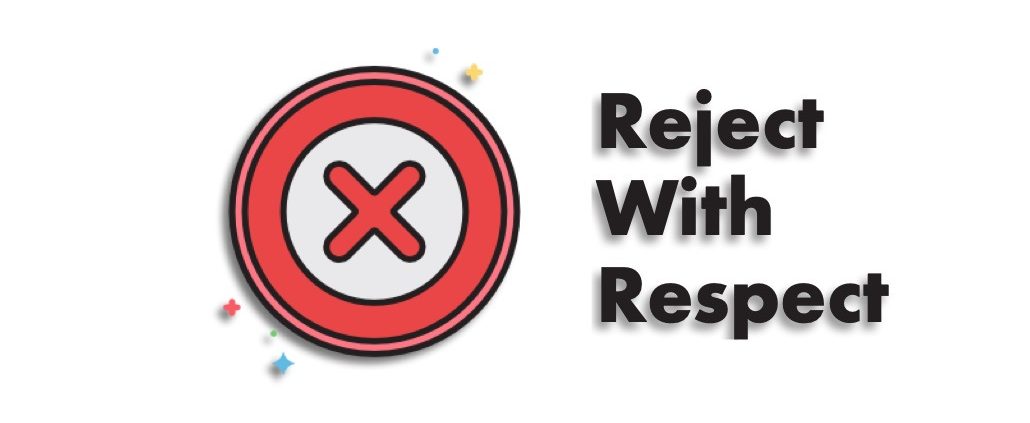Reject With Respect: How to Decline Job Candidates
One of the less glamorous tasks in recruiting and human resources is the responsibility to decline a job candidate when he isn’t the best individual for a role. While it’s not easy or fun, it can and should be done with efficiency, professionalism and respect. After all, if you were in the candidate’s shoes, you’d want to know the final decision on your potential employment status with the organization.
Unfortunately, many employers procrastinate on or even skip this essential candidate communication due to apathy, a lack of organization and/or a poor system for managing candidate follow-up during the hiring process. Not only does this damage the company’s employment brand (and likely the consumer brand), but it also impedes its ability to source a sufficiently stocked candidate pipeline in the future. In fact, according to The Candidate Experience Study (WorkplaceTrends), candidates are 3.5 times more likely to re-apply to a company if they were notified when declined for a previous position.
Put yourself in a position to professionally decline candidates by forming your candidate rejection strategies before you find yourself in the moment. Craft email template options, brainstorm bullet points for phone scripts and role play a “no thanks” conversation with a coworker. In this blog, I’ll share ten employment brand-friendly strategies for passing on job candidates.
1 – Set yourself up for success by setting expectations
I’m a huge believer in setting hiring process expectations with candidates so they understand
- how long it may take to fill the job,
- how many stages are involved,
- whether they will receive an answer on their candidacy regardless of decision made, and
- in which format the answer will be sent.
The desirable impact of this habit is that it forces you–as a recruiter or hiring manager–to stay accountable to telling candidates when they aren’t selected. You wouldn’t want to go back on your word and damage your professional reputation (or that of your organization) by dropping the ball.
2 – Personalize follow-up by hiring stage
Applicant tracking systems make it easy to personalize fields such as name, job title and company in email templates, and employers should create templates for each stage a candidate navigates during the hiring process. For example, while I rely on automated personalization in emails sent to candidates that don’t progress past the application, I make a personal phone call to a silver medal candidate who finished second after the final interview.
However, there are many nuanced approaches that fall in between those opposite ends of the hiring process. I explore them in the following sections.
3 – It’s not never, just not now
How many times have you interviewed a sharp candidate for a specific position who didn’t have the same amount of experience as the individual who finished first? Or, perhaps the personality of the silver (or even bronze) medal candidate wouldn’t have been the perfect match with the hiring manager involved?
There are situations when you really believe in the potential for the rejected candidate to do something at your organization in the future–the timing just isn’t right now. Don’t lose track of these individuals. Instead, engage them in a targeted campaign for future job opportunities, invite them to subscribe to your future job alerts and send them a thank you email with links to follow you on social and read your corporate blog.
4 – We’d love to leverage your strengths elsewhere
I’ve sourced candidates for many sales positions and I always encounter candidates from a wide variety of sales specializations. Some are amazing new client hunters, others excel at managing and nurturing an existing client base, and some would be better suited to driving client acquisition behind the scenes by developing lead acquisition techniques.
When I find a talented individual with the wrong specialization for my current role, I do my best to reroute her to an opportunity that better aligns with her strengths. If your organization is large enough, that may be as easy as inviting her to apply to other roles internally, or making it simple for the candidate by teeing up an introduction to another hiring manager.
If you’re not currently hiring for any other relevant roles, then tag that candidate for future consideration for other job categories with a meaningful status in your applicant tracking software. Then, periodically touch base with her to let her know she is of continued interest to your organization.
5 – You have potential, keep at it
When you encounter an inexperienced candidate with a long runway of potential future performance, invest in a targeted communication approach with that individual. Tag that candidate to receive communications about
- how to prepare for your hiring process,
- the skills and education you require in various job categories,
- opportunities for internships and temp-to-hire roles, and
- future hiring events such as open houses and career fairs where your organization will be represented.
Relative to the other strategies listed here, this tactic is a slow simmer; however, six months to two years down the road that greenhorn candidate may have professionally matured into the best option for your future job listing. Plus, the opportunity cost of nurturing her via email and social over time is usually far exceeded by the short-term costs of paid job board listings and external recruiter fees.
6 – Can I help connect you?
Sometimes the final group of candidates for a position are in a neck-to-neck race to the employment offer. While almost negligible differences may separate their final qualification for a position (e.g. the recommendation of a colleague, a slight difference in pay expectations, their availability to start by a certain day), there’s only one first place finisher.
Don’t lose sight of your opportunity to not only engage those not selected in future opportunities with your organization, but also your privilege to help connect them with your network in the hopes they may land something spectacular elsewhere. This could be as simple as an invitation from you to connect on LinkedIn so that you may facilitate introductions between them and your friends at other organizations.
I’ve employed this approach successfully in my own career when I wasn’t the final choice for an available position. In fact, I’ve sourced new clients as a result of the relationship I maintained with an employer despite being its silver medal candidate for a position. You never know when your path may intersect with an organization again.
7 – Circumstances have changed
Perhaps more frustrating than not finishing first is the feeling a candidate experiences when an employer decides not to fill an open position. After all, the candidate has already invested the time and energy in applying, interviewing and waiting only to not find out whether he was ever qualified to be selected!
While some employers will send a communication to candidates when circumstances prevent the company from filling the position, many have the opportunity to improve that message by commenting on whether the candidate should pursue the position should it become available once again. If a candidate was not a fit for the role even though the role wasn’t filled, be respectful of that candidate’s future time by thanking him for his interest and encouraging him to either develop himself more in specific areas or pursue different avenues in the future.
8 – Thank you with a parting gift
If you feel like parting ways with a job candidate isn’t the sweet sorrow you were seeking, then offer a consolation prize. NOTE: This isn’t for everyone and should be approached with a delicate analysis of the candidate audience relative to your consumer brand. However, particularly if you are a retail brand sourcing part-time positions for various locations, a parting discount or coupon can sweeten the sting of rejection.
For example, as long as I was communicated to and treated with respect during the hiring process, a thoughtful decline note that asks me to keep an eye on future positions and includes a coupon could prompt future job applications from me. In the hourly, part-time employment world, five dollars off my next pizza would encourage my continued patronage of a retail brand I probably already enjoy.
9 – What can we do better?
When we recruit in a vacuum, we can’t expect to improve our process or our hiring outcomes. Therefore, choice employers incorporate a continuous feedback loop into their recruiting workflow by surveying their job candidates.
The key to success with this approach is to customize the feedback request based on both the status and stage of the candidate. After all, an applicant rejected after an initial phone screen will have a different scope of experience than the final candidate who receives the employment offer.
Take action on the nuggets of wisdom uncovered in candidate surveys by stage and produce content that explains how you’ve improved the hiring process. And, because you’ve stayed in contact with previously declined candidates based on strategies mentioned earlier, your future conversion of these boomerang candidates will certainly improve.
10 – A reverence for referred candidates
In the same way that employers have a responsibility to follow-up with all candidates to preserve their employment brand, employers have a duty to follow-up with existing employees who refer candidates. While the explicit details of the employment decision may not be appropriate to share with the referring employee, a general comment about the candidate’s status in the hiring process will always be appreciated.
In addition to sending a sincere thank you to the employee, providing closure about the status of the referral will help ensure that employees continue to make an effort to promote your organization within their networks.
The communication strategy you employ within your hiring process is critically important to the long-term success of your organization. Keeping people respectfully informed of their candidate status will go a long way toward populating your talent pipeline in the future.











 15% OFF FULL-SERVICE HIRING • APPLICANT TRACKING SOFTWARE • ONBOARDING SOFTWARE
15% OFF FULL-SERVICE HIRING • APPLICANT TRACKING SOFTWARE • ONBOARDING SOFTWARE